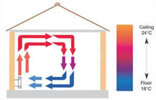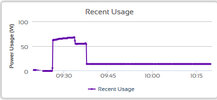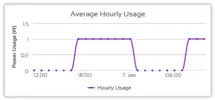Not got a "Smart" meter, I do however have plug in energy monitors, and did have a meter to measure whole house until batteries leaked. The problem was no meter to measure gas or oil in real time, so hard to compare energy costs.
Thermostats don't work like that. Set it to whatever temperature will constantly rise until it gets to that temperature. Setting it higher will not make it rise faster and could cause it to overshoot thus wasting energy.
You set it to the temperature you want the room to be at and then never move it agin.
That may be correct in an ideal world, but in my experience wrong. The problem is our devices are too smart, and try to reduce hysteresis, so mothers house set the TRV to 20ºC at 7 am and it was nearly 11 am before the room was at 20ºC so would set it to 22ºC from 7 to 8 am then 20ºC and it would hold room at 20ºC until ready to retire at 10 pm when it would drop to the Eco setting of 17ºC.
You don't say if you can heat with gas.
Or... should I invest in oil heaters?
Do you mean oil filled radiators or an oil burning boiler? The latter is far cheaper to run than electric.
As to electric you have three methods to heat the home, convection, radiation, or heat pump. A resistive heater be it a fan heater or oil filled radiator will all give out the same heat per pound. However when a fan heater turns off you feel the cold immanently but when an oil filled radiator turns off the effect is delayed. Also the fan heater will heat whole of room equally, but the oil filled radiator will cause thermals and the room will have warm and cool spots

so when I lived in a single glazed hot air centrally heated house, the bills were high, as whole house kept warm, but mothers living room with a radiator place thermometers around the room and they could show 18 - 26ºC depending where placed, morning sun could heat area around the window, but the area next to wall to next room was a lot cooler, in time gone by, we had high backed chairs to protect us from cold drafts.
Infrared heaters don't heat the air, but what is placed in front of them, it is instant heat, it can pass through windows, and it stops as soon as heater is switched off, so only way to control is more or less bars turned on, thermostats don't really work as they monitor air temperature and it does not heat the air. They are very good for instant heat, heat the church for an hour, or bathroom while having a shower, but hard to control. However it can work as a part of the heating system, in fact that is how our open fires have worked for years.
Heat pumps are much cheaper to run, but costly to buy and install.
In the main the way to reduce heating costs is to only heat when required, I have programmable TRV heads throughout my house, I know approximately when each room will be used, so use Eco and Comfort settings, 17ºC for Eco and 20ºC for Comfort, and I keep internal doors closed, so stop heating kitchen at 8 pm, as after that point will only pop in to make coffee, dinning room not used in Winter, that saves on heating, living room turns up at 4 pm ready to watch TV and down again at 11 pm.
Each room has a different program. I use cheap TRV heads in the main, you can get expensive ones which have algorithms that work out how long it takes to heat the room, so you set time you want room warm by, and it works out when it needs to start heating to get room warm just in time. The Drayton Wiser TRV head does this.
However since I don't heat with electric, I use oil, I don't know how the electric heaters do this, clearly they can heat water which is pumped around like any other energy form, in the same way we can have stand alone gas and oil heaters. But main way to reduce cost is to only heat when required, so the things we need to look at is not the base heater, but how we control the heater, my Nest thermostat for example monitors where my wife's and my mobile phones are, and turns down the heating when we are not home.
There is no reason not to heat a room to a base heat, say 17ºC then have PIR controlled Infrared heaters turn one when it senses people in the room, may work with a kitchen, but living rooms and bedrooms we don't move around enough.
In the main the "Smart" meter is useless, as it is measuring too many items to work out what each is using,

this shows my battery charger recharging the battery on my car, I used it so I could see when it was charged, but it does show energy used by one device, be it a freezer, or a heater, I can see what each electric device uses. This

shows my outside Christmas lights turning on and off. The plug in units can use voice commands, although I don't bother, I can say hey google turn on Energy monitor and what ever is plugged in will switch on, the TV advert with a Freddy Boswell look alike clapping his hands is a figment of some ones imagination you can't turn the meter on and off, only the supplier can do that, and using clapping of hands would not be very convenient, too easy to turn on/off in error.
What would be a good idea is a stand alone electric heater which has the same algorithms as the Drayton Wiser TRV heads, so you can set the time when you want the room warm, however I don't know of any, I am sure some one will through.






